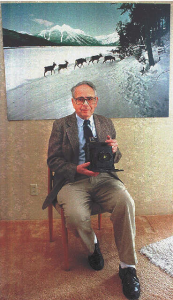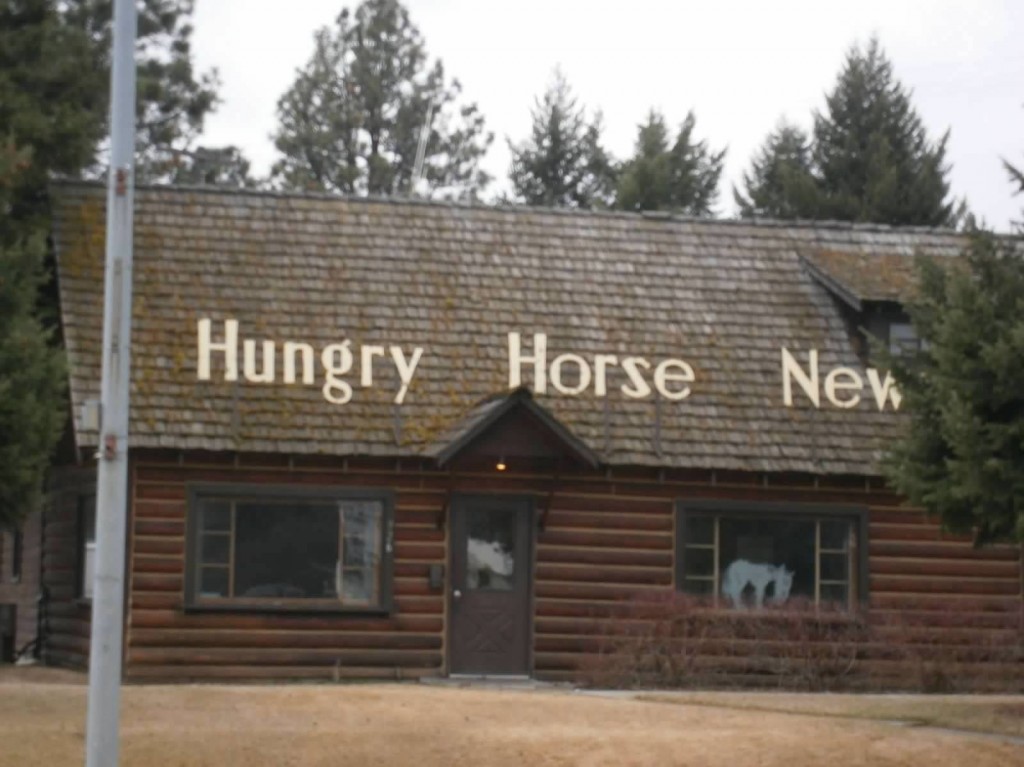The annual Pulitzer Prizes will be announced later today, celebrating the best of the best in journalism. You can see this year’s winners here after 3 pm ET.
It’s become a tradition for me to honor the day and the importance of local papers and the reporters who work for them by running this story about an editor and publisher of a small-town weekly in Montana who became the first journalist in the state to win a Pulitzer. I hope you find it as inspiring as I do. I’ve deactivated comments on new posts but I kept them open for this – be sure to read them. — Michelle
* * *
Mel Ruder was just of the U.S. Navy when he moved to the Flathead Valley area of Montana, near Glacier National Park, to start a weekly newspaper. He promised to fill it with photographs of “babies, beasts, and beauties,” and lots of positive news, according to Pictures, a Park and a Pulitzer, a 2000 photo book showcasing his work.
Ruder worked long hours, and according to the book, eventually assembled a small staff of full-time and part-time reporters and editors. At some point, he moved the paper’s office to a log cabin on the corner of Hwy 2, just outside of Columbia Falls, where it still stood when I visited the area in 2012. That’s the office in the picture at the top of the post.

In June 1964, when heavy rains flooded the valley, Ruder was all over the story. “He went out on the floodwaters in a boat, and when the road was washed out he drove his car down the railroad tracks to photograph flood scenes,” the New York Times wrote in his 2000 obituary. “He worked day and night for nearly a week, feeding news steadily to The Associated Press and radio stations in the area.”
Hiring a Plane for a Better View
Ruder even hitched rides on small planes to get an aerial view of the damage, according to Pictures, a Park and a Pulitzer.
To keep local readers up with the events, he printed as many as 12,550 copies of the Hungry Horse News a day, compared with normal circulation of 3,900 a week.
Ruder was proud of the work he and his staff did covering the flood, and asked a journalist friend in Missoula to submit a nomination to the Pulitzer committee on their behalf.
The following April, Ruder was at work, photographing a local school event, when he got a call. For their coverage of the flood, the Hungry Horse News had received the Pulitzer Prize for Distinguished General Local Reporting, making them the first journalists in the state to be so honored.
When asked how he felt about receiving such as prestigious award, he said – on more than one occasion, according to the book – “I guess I can die now.”
Instead, Ruder continued to work at the newspaper until he sold it and retired in 1978.
Pictures, a Park and a Pulitzer
Before my first visit to Montana, I’d never heard of Ruder or the Hungry Horse News, named after a small town that’s not much more than a gas station, grocery store and a handful of shops where tourists on their way to Glacier National Park can buy huckleberry jam, pie or just about anything else made with huckleberries.
While staying in the area, I saw Pictures, a Park and a Pulitzer a couple different places and was intrigued enough that I asked to borrow a copy to read more.
I can imagine there are many modern day Mel Ruders writing local news and hoping that one day, if they were lucky, they’ll be called upon to cover a natural disaster, strike, pandemic or another story significant enough that it could make their career and even win an award.
But given the realities of today’s news business, it’d be tough. For every Malheur Enterprise or Flathead Beacon telling important stories and keeping government agencies accountable to the public, there are hundreds of papers that have downsized or folded, creating news deserts in many parts of the country.
Ruder was lucky. He called his own shots. He didn’t have to check in with the head of digital content in New York for permission to spend extra on hiring or other expenses.
Ruder’s Pulitzer story is worth remembering not only as a reminder that local news did and does still matter. It also serves as a reminder that when it comes to community journalism, the bar doesn’t have to be set artificially low.

I posted this on Linkedin, and on my Google Reader… Would it be feasible to connect on Linkedin?
I was excited to find this blog when researching my family history. On the Road Again is a story of our family reunions throughout the years, from the first one in Bartlesville, OK, to the beaches in Yachats, OR. Our largest family reunion was at Flathead Lake with 40+ attendees; fortunately, our 90-year old aunt lived close, and was one of two surviving members of my father’s generation. Plus, her son and our cousin, Mel Ruder, and other multi generations. Three clips of the reunions, and a picture are published in Reunions’ magazines, thanks to Editor, Edith Wagner.
Diane: I’m so glad you enjoyed my story about your relative, Mel Ruder, the publisher of the Hungry Horse News. I really enjoyed learning about the history of the area when I was there last year – so much that I’m going back again next spring!
Michelle Rafter
The history of the area is fascinating; I have been researching the Big Blowup of 1910, the largest forest fire in American history. It burned over three million acres of forests;
altogether, 85 people died, including dozens of firefighters.
I am a mentor for Salt Lake (City) Community College Writing Center – DiverseCity writing group.
My freelance article, Central Utah Getaway was published on vroom.girls.com, posts on grindstone.com, mint.com/blog..
I am interested in your WordCount writer chat.
Thank you,
Diane Lockard
Michelle:
You made a wise choice to bring Mel Ruder to the attention of writers and readers. Mel was a humble man who worked very hard to serve his community and produce a high-quality newspaper.
He started out with very little, but died a Pulitzer Prize winner who was revered across the state, a financially successful man who had quietly given away piles of cash to assist education and reading.
I wrote the text for “Pictures, a Park and a “Pulitzer,” and was so lucky to know and work with Mel.
People who write and edit, and most of all shoot photos, should try to come anywhere close to Mel and attempt to aspire to his heights as an editor. If we do, we will find ourselves atop a very high peak, just like the ones in his beloved Glacier National Park.
Tom, thank you so much for sharing your insights on Mel Ruder, and for finding my post about him from almost a year ago. I discovered Ruder on my first ever trip to Montana almost a year ago, and reading your book about him and his newspaper helped drive home what a special place it is. In fact, we had so much fun we’re headed back next month!
Michelle Rafter
More power to him! I love stories like that. Good old fashioned hard work and diligence.
i too was fortunate enough to work in this realm of the Hungry Horse News weekly newspaper that Mr. Ruder had created. I knew Tom Lawrence as well as he was around part of the time i was. Northwest Montana is a very unusual different kind of a world compared to the rest of the country if you are from elsewhere. It is like stepping back in time 50 years or so. Nothing wrong with that just unusual.
I worked for this paper and other sister paper weeklies in the area for some 11 years as advertising production manager. As the Hungry Horse has changed ownership more than once and multiple other city weeklies have been added to the chain from surrounding towns/cities. I learned much here, matured and enjoyed it.
Unfortunately advertising for the (all) papers has become worse resulting in my layoff. i currently am working in the thriving gloss magazine industry in southeast FL.
Matt Epperson